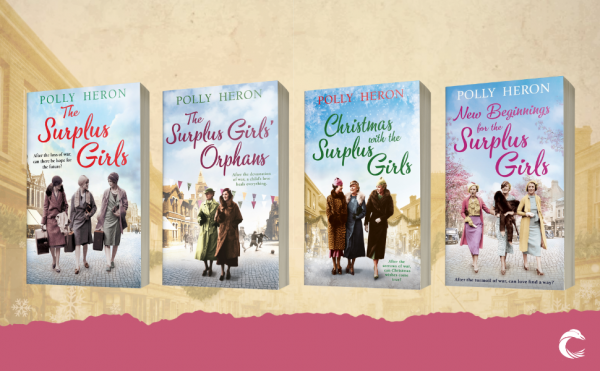
Welcome to Polly Heron's website.
I am a saga writer living on the North Wales coast, but I am originally from Manchester, which is where my books are set.
I am represented by Camilla Shestopal of Shesto Literary.
I also write as Susanna Bavin and as Maisie Thomas. I am on Facebook as Maisie.
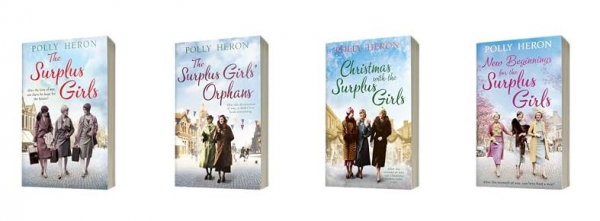
Three Surplus Girls books in one Kindle volume
|
Just a reminder that you can get the first three Surplus Girls books in a single Kindle volume.
|
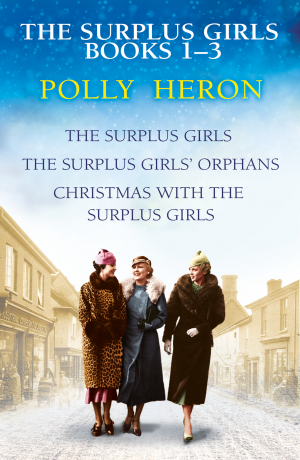 |
""
"
Books on Kindle Unlimited:
All four of my Surplus Girls books are available on Kindle Unlimited. Click here for the link.
h
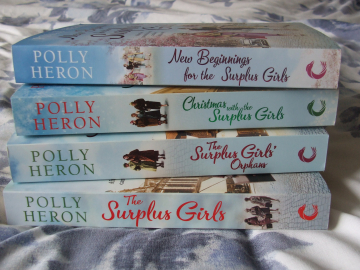
| Also on Kindle Unlimited is The Deserter's Daughter, one of my 1920s sagas written as Susanna Bavin.... | 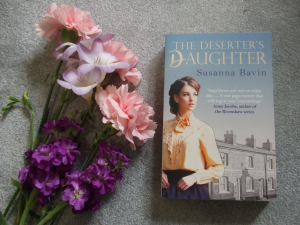 |
.... and also my Home Front Girls series.
h


Who were the Surplus Girls?
The Great War wiped out a generation of young men and left behind a generation of young women who faced a life without the probability of marriage, at a time when any girl left on the shelf rapidly became an old maid and no working woman could hope to earn what could be earned by a man, even by a man doing the same job. These were the ‘surplus girls’ – young women who had grown up assuming they would get married, but whose dreams and assumptions were dashed by the War; young women who, unexpectedly and without preparation, faced a lifetime of work and spinsterhood.
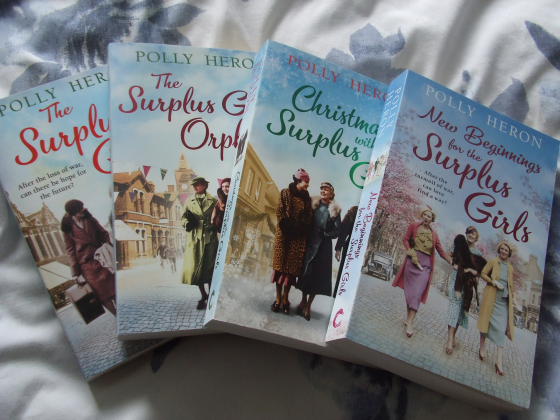
The Home Front Girls
written as Susanna Bavin
My Home Front Girls series is set in a salvage depot in the south of Manchester and follows the fortunes of Sally, Betty, Lorna and their families and friends.
The books are available on Kindle and Kindle Unlimited and in paperback.

‘Completely captured me.. so heart-warming and I love spending my morning with a coffee and a (fair few) chapters of this book!’ stuck_in_the_book_loop ⭐⭐⭐⭐⭐
‘Absolutely beautiful heart-warming saga… Fantastic… I loved it.' Goodreads reviewer ⭐⭐⭐⭐⭐
‘I loved being back with the girls… Beautiful… I love every single instalment.’ Goodreads reviewer ⭐⭐⭐⭐⭐
‘I have loved every book and it’s always a joy to be reunited with Sally, Betty and Lorna… Wonderful… Delightful.’ thebookjunction ⭐⭐⭐⭐⭐
‘Phenomenal… truly remarkable and amazingly unpredictable.’ Goodreads reviewer ⭐⭐⭐⭐⭐
‘A tearjerker and had me gripped! Excellent.’ lisabooksreviews
If you enjoy my Home Front Girls series, you may be interested in reading about the background to it:
“There’ll Always be a Dustbin…”
A Look at Salvage and Recycling on the Home Front
When I was invited to write the Home Front Girls series, I gave a lot of thought to its background. I settled on salvage – what we today know as recycling – because it played such a huge part in the nation’s ordinary everyday life.
Salvage was a massive part of the war effort on the home front. Everything was in increasingly short supply as items vanished from the shops, never to be seen again until after the war – ordinary things like hair-pins, paper-clips (a bag of paper-clips was once offered as a prize in a raffle), hair-pins, needles, pencils, coat-hooks… My grandfather described finding a coat-hook in the soil when he was digging for victory. Did he chuck it away? Absolutely not. It was given a good clean and put to use.
During the war, re-using was essential. Many items were re-directed into another purpose. Three or four layers of wool fabric for the soles, with a piece of old curtain, tapestry or even old carpet for the tops, and hey presto – a pair of slippers. The shirt-tails could be cut off a man’s shirt and made into a new collar and cuffs when the old ones wore out. Old shirts and blouses were turned into baby-clothes, and many a blanket found a new life as a winter coat. The WVS (Women’s Voluntary Service) ran clothes exchanges, where you could choose something ‘new’ in return for a good-quality donation. Women’s magazines were full of clever ideas for giving clothes a new lease of life, such as turning a full-length coat that was past its best into a hip-length coat and using the left-over fabric to make a smart new collar and pocket-flaps.
But it wasn’t just in the home that salvage and recycling worked wonders. ‘Saucepans into Spitfires’ was the popular and inspirational slogan for a national drive to collect aluminium throughout the summer of 1940, when the Battle of Britain was being fought in the skies. The housewives of Britain proudly gave up their pots and pans, vacuum-cleaner tubes, coat-hanger hooks, and anything else metallic they could find around the house.
In the words of Lady Reading, the leader of the WVS, speaking to women in a wireless broadcast in July 1940, ‘Very few of us can be heroines on the battle-front, but we can all have the tiny thrill of thinking as we hear the news of an epic battle in the air, “Perhaps it was my saucepan that made part of that Hurricane!”’
Throughout the war, everything was salvaged – paper, string, metal, glass, rubber, rags, wood, even rabbit fur after Bunny had been killed for the cooking pot, often to appear on the Christmas dinner table as mock-turkey. Food-waste went into the pig-bin, except for the bones, which went in the bone-basket (to make glue, explosives, soap, fertiliser and animal-feed). Silver-foil milk-bottletops were kept and given back to the milkman – or more likely to the milk-lady, who had taken over the job when the milkman was called up.
The Control of Paper Order 1940 stated that items bought in a shop should not be packed or wrapped if this wasn’t necessary. In the spring of 1943, it became an offence to throw away waste paper. At a time when few people had a telephone at home, the main way to keep in touch was by letter. Envelopes were re-used until there was no space left to write another address and people who had been brought up to write on only one side of the paper now wrote on both, with no margins. If young Billy had been off sick from school and his mother, or his foster mother if he was an evacuee, had to write a note to the teacher to excuse his absence, this was probably done on the reverse of a piece of paper that had already been written on – so it was probably a good idea to check what had been written on the other side, just in case.
A salvaged newspaper could be made into three 25-pound shell cups. One envelope could become a cartridge wad. A mortar shell carrier could be made from half a dozen books, while sixty large cigarette cartons could be turned into the outer container for a shell. One 9-inch enamel saucepan might become a bayonet. Even the ‘snippings’ of cotton or wool from a housewife’s sewing or knitting could end up forming part of a soldier’s winter coat or an army blanket.
As for the humble rag… maps and charts for submarines, bomber crews and tank crews; wipes for cleaning machinery; battle-dress; blankets; roofing-felt for army barracks.
The responsibility for the collection of salvage lay officially with the local corporations, but the work mainly became the job of local women, almost always the Women’s Voluntary Service. This was partly because in the early years of the war, corporation refuse-carts were often needed for clearing up the rubble after air raids.
Salvage also became a job for children. Hundreds of thousands of children joined the ‘cog’ scheme – each of them becoming a small cog in the mighty war machine. Schools, scout groups, guides and brownies competed with one another to collect the most salvage in their local neighbourhoods. Newspapers ran a ‘cog’ page each week for children and a special song was written called ‘There’ll Always Be a Dustbin’, which was sung to the tune of ‘There’ll Always Be an England’. Working towards earning their ‘cog’ badges was an important part of wartime life for many youngsters.
So the next time you’re sorting your recycling, preparing to put it out for collection in the various boxes, spare a thought for our salvage-minded wartime generation, who by the time D-Day came round had provided 1.1 million tons of waste paper, 1.3 tons of metal and more than 80,000 tons of rags to help fight the Second World War.
The Wartime Hotel
written as Maisie Thomas

My new WW2 series is set in Dunbar's Hotel. The first book is out; the second can be pre-ordered; and the third will be out in spring 2026. Here is the Amazon link.
During the Second World War, an obvious feature of air raids was being bombed out. This meant your home was destroyed or else rendered uninhabitable. The normal thing to do in this situation was to move in with family, something that thousands upon thousands of people all over the country were obliged to do. When this happened, it almost always lasted for the duration of the entire war.
The worst time for air raids was the summer of 1940 through to the summer of 1941. If you lost your home during that time and had to move in with Auntie Ethel, the chances were that you’d still be at Auntie Ethel’s when the war ended in 1945… and for some considerable time afterwards.
It wasn’t just people who got displaced. Their possessions did too. In many cases, if a house took a direct hit, then all the furniture and other things were blown to smithereens; but if a house was simply damaged and made uninhabitable, very often many of the possessions were left intact – and they all had to be stored somewhere. You couldn’t take them with you to Auntie Ethel’s because she hadn’t got enough space, not least because Grandma, Auntie Flo, Cousin Rodney and the cat had also been bombed out and had moved in with her as well.
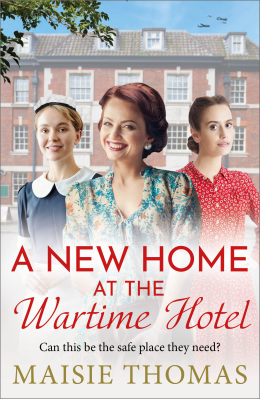
So where were all these possessions put? There were what we would refer to as storage facilities, but you won't be surprised to hear that these got filled up pretty quickly. People had to make whatever arrangements they could.
How about a small hotel, where they’ve lost all their guest-room furniture to the bailiffs, so they set themselves up as a storage place? Welcome to Dunbar’s!

The Railway Girls
written as Maisie Thomas
My Railway Girls series is set - of course! - in Manchester and follows a group of women of various ages and from different backgrounds, who are all sent to work on the railways during the war.
To give you a flavour, here is the prologue to the series:
On February the 14th 1922, at the western-most entrance to Victoria Station in Manchester, a massive memorial was unveiled. It filled an entire wall, the top half of which was made up of coloured tiles laid out to depict a map of the old Lancashire and Yorkshire Railway. Below this stretched a row of one, two, three, four… nine bronze panels in all. The panel at the right-hand end showed St George on his rearing horse, using his spear to slay the dragon. At the left-hand end stood St Michael the Archangel, sword aloft, his foot on the neck of a vanquished Lucifer. These two panels were each flanked by two narrower panels depicting flaming torches, each one bearing a single word: UNITY, STRENGTH, COURAGE and SACRIFICE.
This tablet is erected to perpetuate the memory of the men of the Lancashire and Yorkshire Railway whose names are recorded and who gave their lives for their King and Country in the Great War 1914-1919.
The seven bronze panels in between those of the two saints were engraved with long lists of the names of the fallen, men who had left their jobs on the railway to fight in the Great War. A total of 1,460 men from the Lancashire and Yorkshire Railway gave their lives in the war to end all wars.
* * * *
In early March 1940, a group of women stands in front of the war memorial. They are of varying ages and backgrounds and come from different social classes – a solicitor’s wife, a factory-owner’s daughter, a sewing machinist, a debutante, a working-class housewife, a clerk, a young wife who has been wrapped in cotton wool and a girl who wasn’t tall enough for the switchboard. On the surface, they form a diverse group, but they have one thing in common: their willingness and determination, under threat of invasion, to do their bit in this new World War by rising to the challenge of working as railway girls.
Unity, strength, courage and sacrifice.
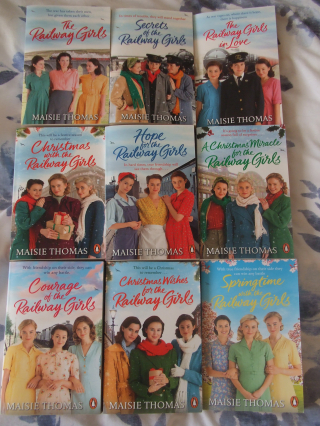
Heritage Railway Pictures
| If you'd like to see some photos of the types of railway things you read about in the Railway Girls books, then click here to be taken to my blog. | 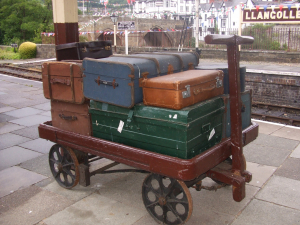 |
Meeting Dot
|
If you enjoy the Railway Girls series, written as Maisie Thomas, you may like to look at this blog about Dot Green, a Railway Girls character who captured readers' hearts right from the start of the series.
Click here to see the blog. |
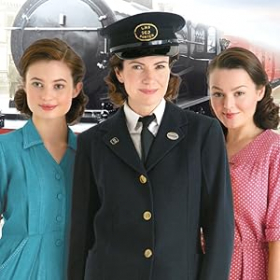 |
